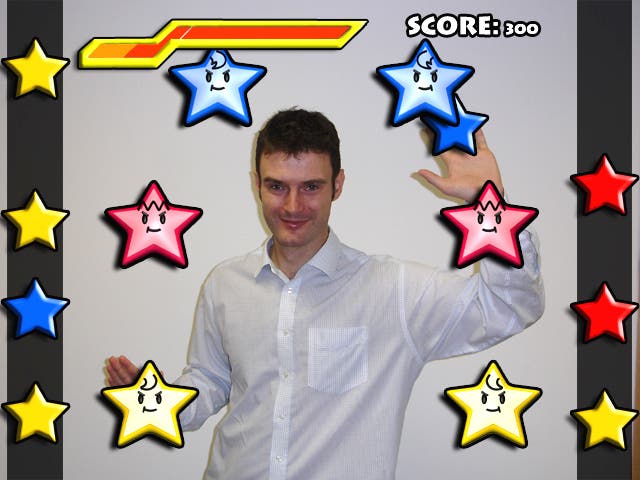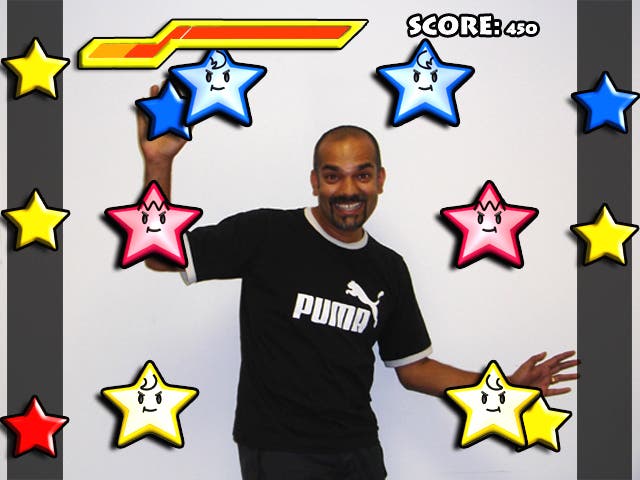Rhythmic Star
EyeToy fun for none of the family.
It's coming up to three years since the EyeToy first appeared in our living rooms, introducing a whole new audience of people too young, too old or just too plain drunk to operate a Dual Shock to gaming. Since then, there have been all manner of variations: two more instalments in the Play series, a Chat title, SpyToy, Kinetic - some sort of fitness trainer thing involving Nike - and a rather rubbish hoverboarding game.
Now, here comes Rhythmic Star - an EyeToy dancing game that has a lot in common with Sony's EyeToy: Groove. As in, it's a dancing game, that works with the EyeToy, and you have to wave your arms about a lot. To music.
But there the similarities end. For while EyeToy: Groove is a nicely polished, well put together party title, complete with licensed tracks, a decent selection of multiplayer modes, some funky mini-games and a few nifty extras, Rhythmic Star is nothing more than bargain basement rip-off fodder.
For starters, there's the song choice - there are 25 in total, which, to be fair, is a decent enough number. They include classical tracks such as Vivaldi's Four Seasons for the oldies, Incey Wincey Spider and the like for the kids, plus pop hits such as Madonna's Material Girl, Kylie's Can't Get You Out of My Head and the Beach Boys' Surfin' USA.
Except none of those are really Madonna's, Kylie's or the Beach Boys', of course - they're cover versions, with vocals performed by people who'd be laughed out of a Stars in Their Eyes audition and backing music performed, we can only assume, by some poor bloke with a Bontempi organ sitting in a tin shack. In 1983.
But bad cover versions isn't Rhythmic Star's main problem - that lies with the gameplay itself. It's simple enough in principle; coloured stars drop down on the sides of the screen, then bounce off the bottom into bigger stars, and you've got to hit them at exactly the right moment to score points.
You've also got to hope that the game will recognise the fact that you've hit them at exactly the right moment, since all too often, it fails to do so. There's no clear explanation for this (and no, it's not just because we're rubbish at dancing, as anyone who's seen us riverdance through the entire 12 inch remix of B*witched's C'est La Vie will testify). The game only seems to reward you with points when it feels like it, regardless of how well you're playing, which means it all gets very frustrating very quickly.
Pill popping

There are opportunities to earn bonus points in the form of Pac-Man notes (this is a Namco game, remember) - these will appear if you perform a good enough combo, and if you hit them they'll multiply your score. Rapid notes consist of a series of stars all bundled together, and you hit them by holding your hand still in the right position. Thrilling.
So, rubbish songs and shonky gameplay - Rhythmic Star's not doing well so far, is it? But wait - there's always the varied selection of modes you can choose from. Or rather, the three modes you can choose from, which are not really very varied at all. Oh dear.
First up is Main, which involves picking a song, choosing a difficulty level, and waving your arms around as described above. Tediously, not all the songs are unlocked at first, so you'll have to do a lot of this if you want to access them all.
Then there's Survival mode - this time, you pick a block of songs, choose a difficulty level, and wave your arms around for five tracks in a row. If you miss a note, your Survival Gauge will go down, and if it hits zero it's game over. The end.
Getting serious

And finally, there's Versus mode, where up to four people can take it in terms to compete each against each other. Technically, there are two multiplayer options here - Party or Serious. But the only difference between these, as far as we can gather from both playing the game and extensively studying the manual, is that Serious mode throws in question mark notes from time to time, which can increase or decrease your score. You won't know which till you see the surprise bonus screen at the end. You won't care.
With both the Party and Serious options, there's just one way to play - you take it in turns to stand in front of the screen and play the game just in single player. No simultaneous two-player battles, no co-op, and no mini-games - unlike with, you guessed it, EyeToy: Groove.
Which means Rhythmic Star is unlikely to entertain your party guests for longer than it takes them to ask you if you've got a number for a mini-cab. And since multiplayer is really the whole point of EyeToy games - what with standing alone in your lounge waving your arms at the telly being no fun at all - there's really not much point to Rhythmic Star.
Yes, it's only £14.99 - but since you can find EyeToy: Groove for less than a tenner these days, complete with licensed tracks, neat extras such as the option to video parts of your peformance, and gameplay that ACTUALLY WORKS, that's not nearly enough to make Rhythmic Star worth considering. For proper PS2 rhythm action fun, go for Groove (assuming, of course, that you've already got Guitar Hero and have played it so much that EyeToy games are the only ones you can play without your blisters bursting).








